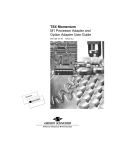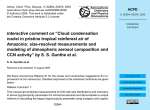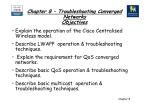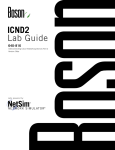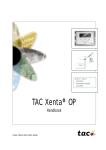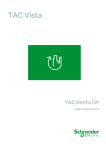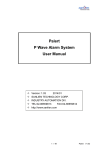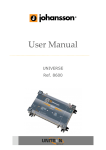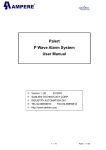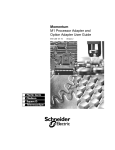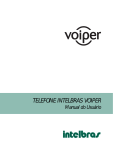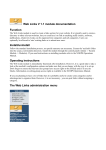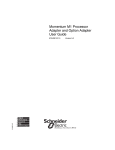Download Quantum Automation Series
Transcript
Quantum Automation Series Network Option Module for LonWorks 31002028 01 840 USE 109 00 Version 3.0 2 840 USE 109 00 May 2001 Table of Contents About the Book . . . . . . . . . . . . . . . . . . . . . . . . . . . . . . . . . . . . . . . 5 Chapter 1 Description of NOL Module . . . . . . . . . . . . . . . . . . . . . . . . . . . . . 7 At a Glance . . . . . . . . . . . . . . . . . . . . . . . . . . . . . . . . . . . . . . . . . . . . . . . . . . . . . . 7 Description and Performance Factors. . . . . . . . . . . . . . . . . . . . . . . . . . . . . . . . . . 8 Connectors and Push-buttons. . . . . . . . . . . . . . . . . . . . . . . . . . . . . . . . . . . . . . . . 9 Front Panel Illustration . . . . . . . . . . . . . . . . . . . . . . . . . . . . . . . . . . . . . . . . . . . . 11 LED Indicators. . . . . . . . . . . . . . . . . . . . . . . . . . . . . . . . . . . . . . . . . . . . . . . . . . . 12 Before You Begin . . . . . . . . . . . . . . . . . . . . . . . . . . . . . . . . . . . . . . . . . . . . . . . . 14 Chapter 2 Hardware Installation . . . . . . . . . . . . . . . . . . . . . . . . . . . . . . . . . 17 At a Glance . . . . . . . . . . . . . . . . . . . . . . . . . . . . . . . . . . . . . . . . . . . . . . . . . . . . . Proper Configuration and Mounting of an NOL Module in a LonWorks Network Mounting NOL Module in Backplane. . . . . . . . . . . . . . . . . . . . . . . . . . . . . . . . . . Cable Connections . . . . . . . . . . . . . . . . . . . . . . . . . . . . . . . . . . . . . . . . . . . . . . . Power Up and Power Down . . . . . . . . . . . . . . . . . . . . . . . . . . . . . . . . . . . . . . . . Module Status . . . . . . . . . . . . . . . . . . . . . . . . . . . . . . . . . . . . . . . . . . . . . . . . . . . Chapter 3 Software Configuration . . . . . . . . . . . . . . . . . . . . . . . . . . . . . . . 23 At a Glance . . . . . . . . . . . . . . . . . . . . . . . . . . . . . . . . . . . . . . . . . . . . . . . . . . . . . Overview of Configuration Process . . . . . . . . . . . . . . . . . . . . . . . . . . . . . . . . . . . DX Loadable Function Blocks . . . . . . . . . . . . . . . . . . . . . . . . . . . . . . . . . . . . . . . Using Modsoft or Concept for I/O Mapping . . . . . . . . . . . . . . . . . . . . . . . . . . . . . Installing NOL Configuration Tool . . . . . . . . . . . . . . . . . . . . . . . . . . . . . . . . . . . . Chapter 4 23 24 29 31 34 Maintenance . . . . . . . . . . . . . . . . . . . . . . . . . . . . . . . . . . . . . . . . 37 At a Glance . . . . . . . . . . . . . . . . . . . . . . . . . . . . . . . . . . . . . . . . . . . . . . . . . . . . . Wink Error Code Identification. . . . . . . . . . . . . . . . . . . . . . . . . . . . . . . . . . . . . . . Removing and Replacing the Module . . . . . . . . . . . . . . . . . . . . . . . . . . . . . . . . . Upgrading Firmware in the Module . . . . . . . . . . . . . . . . . . . . . . . . . . . . . . . . . . . When to Use Reset and Service Buttons . . . . . . . . . . . . . . . . . . . . . . . . . . . . . . 840 USE 109 00 May 2001 17 18 19 20 21 22 37 38 39 40 41 3 Appendices . . . . . . . . . . . . . . . . . . . . . . . . . . . . . . . . . . . . . . . . . . . . . . . 43 At a Glance . . . . . . . . . . . . . . . . . . . . . . . . . . . . . . . . . . . . . . . . . . . . . . . . . . . . . 43 Appendix A Specifications. . . . . . . . . . . . . . . . . . . . . . . . . . . . . . . . . . . . . . . 45 At a Glance . . . . . . . . . . . . . . . . . . . . . . . . . . . . . . . . . . . . . . . . . . . . . . . . . . . . . 45 General Specifications . . . . . . . . . . . . . . . . . . . . . . . . . . . . . . . . . . . . . . . . . . . . . 46 Agency Approvals . . . . . . . . . . . . . . . . . . . . . . . . . . . . . . . . . . . . . . . . . . . . . . . . 47 Index 4 . . . . . . . . . . . . . . . . . . . . . . . . . . . . . . . . . . . . . . . . . . . . . . . 49 840 USE 109 00 May 2001 About the Book At a Glance Document Scope This manual covers the installation, operation, and maintenance of the Quantum Automation Series Network Option Module for LonWorks® (NOL). The NOL module provides connectivity between a Modicon Quantum controller and a control network based on Echelon’s LonWorks® technology.This manual does not include a comprehensive discussion of LonWorks® or of the Quantum Automation Series Programmable Logic Control family. Refer to documentation from Echelon® Corporation to learn more about LonWorks® technology. For information on the Quantum products, see the section below on related documentation. Validity Note This is the second version of this manual. It is a guide to the application of the Quantum NOL module as an interface between Quantum controllers and a LonWorks network. Related Documents 840 USE 109 00 May 2001 Title of Documentation Reference Number Modicon TSX Quantum Automation Series Hardware Reference Guide 840 USE 100 00 Modicon Ladder Logic Block Library User Guide 840 USE 101 00 Modicon ModLink User Guide 890 USE 129 00 Modicon ModLink User Guide 890 USE 129 00 Modicon Programmer User Guide 890 USE 129 00 Modbus Protocol Reference Guide PI-MBUS-300 Concept User Manual 372 SPU 440 01 5 Product Related Warnings User Comments 6 We welcome your comments about this document. You can reach us by e-mail at [email protected] 840 USE 109 00 May 2001 Description of NOL Module 1 At a Glance Purpose This chapter gives a functional description of the NOL module. In addition, there are discussions on performance and interaction with applications, and connectors and indicators. Finally, tips and cautions for the startup phase. What’s in this Chapter? This chapter contains the following topics: Topic Description and Performance Factors Connectors and Push-buttons Front Panel Illustration 840 USE 109 00 May 2001 Page 8 9 11 LED Indicators 12 Before You Begin 14 7 Description of NOL Module Description and Performance Factors Functional Description The NOL module provides connectivity between a Modicon Quantum controller and a control network based on Echelon’s LonWorks® technology. Some of the features are: l module operates as a fully-functional node on a LonWorks network l can operate as a passive or active participant on a LonWorks network l conforms to requirements of LonMark Interoperability Guidelines, Version 3.0, l l l l l NOL Performance and Effect on Your Application 8 including conformance to guidelines for layers 1 - 7 of the ISO/OSI reference model. supports up to 240 SNVTs with up to 31 bytes per SNVT supports user-defined network variables (CNVTs) compatible with Quantum Automation Series controllers, communicates to controller across backplane multiple modules can operate on local or remote Quantum backplanes using standard I/O mapping techniques uses 3150 Neuron Chip The data throughput of the NOL module depends on a number of factors. Performance depends on the number of network variables that have been configured. The LonWorks network traffic will also affect the NOL module throughput. When you are designing applications you must consider this factor as it relates to scan times and required update rates for the contacts and registers used in the ladder logic program. 840 USE 109 00 May 2001 Description of NOL Module Connectors and Push-buttons RS-232 Configuration Port LonWorks Communications Ports This is a 9 pin, D-shell, female, RS-232 compatible serial port wired in a 3 wire DTE configuration; see the following table. Data transmit, data receive, and signal ground are supported; no hardware handshake signals are presented. The port is configured at a fixed rate of 9600 baud, 8 data bits, 1 stop bit, and no parity. This port is used to download configuration and new firmware to the module. It can be direct connected to the communications port of a PC with a cable which swaps transmit and receive signals. The port supports the XMODEM protocol along with an ASCII terminal based command processor for configuration of downloads to the module. Modbus cables make a suitable connection between a PC serial port and the Configuration port on a NOL module. The following ModBus cables are available: 990 NAA 263 20, 990 NAA 263 50. Pin Number Signal Pin Number Signal 1 N/C (not connected) 6 N/C 2 RXD receive data 7 N/C 3 TXD transmit data 8 N/C 4 N/C 9 N/C 5 signal ground The Primary and Auxiliary ports are wired in parallel for flexibility. They are both standard interfaces to LonWorks networks. Wiring polarity concerns are minimized due to the polarity insensitivity of the twisted pair LonWorks transceivers. Primary LonWorks Communications Port This is the primary interface for wiring into a LonWorks network. The connector is a two position 5.08 mm screw terminal. Auxiliary LonWorks Communications Port This is the auxiliary interface for wiring into a LonWorks network. The connector is an eight position RJ-45 socket. (Reference Echelon Engineering Bulletin 174, "Junction Box and Wiring Guidelines for Twisted Pair LonWorks Networks") Service Pin push-button 840 USE 109 00 May 2001 Provides stimulus for LonWorks network installation. Depressing this switch causes the Service LED to illuminate, and forces the Neuron Chip in the module to output its unique 48-bit ID and program ID. See the network management tool documentation for more information. 9 Description of NOL Module Reset pushbutton 10 Performs a hardware reset of the module. The module needs to be reset after new firmware has been downloaded. This push-button allows you to reset the unit without removing it from the backplane. The button is recessed and requires a paper clip or similar tool for activation. 840 USE 109 00 May 2001 Description of NOL Module Front Panel Illustration Illustration This illustration provides a front panel view of the NOL module connectors and indicators. 140 NOL 91120 I/F to LonWorks‚NET LED Display Neuron ID Domain Subnet 1 RS-232 Serial Configuration Port Subnet 2 Node ID Service Pin Reset Button Executive Version Auxilliary LonWorks Communication Port* Primary LonWorks Communications Port *Not intended to be connected to any public telecommunications network. See declaration on Telecommunications Declaration , p. 20. 840 USE 109 00 May 2001 11 Description of NOL Module LED Indicators LED Descriptions 12 There are 6 LEDs on the front panel. The service LED is orange; the rest are green. The meanings of the LED Indicators are described below: Active Indicates the state of module configuration. When lit, the Active LED signifies that the module has received a valid network variable configuration and I/O mapping. In addition, this LED indicates the module is communicating with the DX Loadable at the CPU. You expect to see the Active LED illuminated when the NOL module is operating with a valid configuration. If not lit, either the module requires configuration and mapping or it is not communicating with the CPU by way of the DX Loadable. Ready Indicates the module has passed internal diagnostics and initialization. Upon powerup, after a short delay, the module should make this LED active, indicating the module is either ready to be configured or transfer into an active state. The Ready LED will blink once per second if the module has no internal errors, but needs a configuration loaded. If a module is inserted into a backplane and Ready LED does not illuminate, the Wink LED should be observed for an error code. MsgIn Flashes briefly (10 ms) when an update message for a bound network variable is received by the NOL module from the LonWorks network. MsgOut Flashes briefly (10 ms) when an update message for a bound network variable is transmitted by the NOL module to the LonWorks network. Wink Flashes briefly when the NOL module receives a wink message from the LonWorks network. This LED is also used to display internal error codes defined in Maintenance, p. 37. Srvc Indicates status of LonWorks network service. It is normally Off in a running system. Flashing means module is in an unconfigured state on the LonWorks network. 840 USE 109 00 May 2001 Description of NOL Module LED Indicator Status The LEDs indicate the status of the NOL module, as shown in the following table: The following table shows what the status of each NOL Module LED Indicator means. LED Color Powered Up Powered Up Not Configured Not Configured Not Programmed Not Programmed Normal Operation Error Condition Configured Programmed 840 USE 109 00 May 2001 Ready Green Blink On On Off Active Green Off Off On Msg In Green Off Off Blink Msg Out Green Off Off Blink See the description in [LED Descriptio ns, p. 12 Wink Green Off Off Blink on command. Blink/See description inLED Descriptio ns, p. 12 Srvc Yellow Off Blink Off See the description in LED Descriptio ns, p. 12 13 Description of NOL Module Before You Begin Items Included with Product The NOL module and this user’s guide are sold separately. The following list describes what items are included with the product shipment. l NOL module with the Read Me First sheet, part number 043512579. The Quantum Network Option Module for LonWorks User Guide must be ordered separately. Included with the manual is a set of 3.5 inch diskettes containing: l l l l Other Components Required for Operation 14 NSUP.exe DX Loadable Function Block software NOL DX Loadable Function Block software NOL Configuration Tool software Modsoft Help file for NOL loadable You will need the following items to install and use the NOL module in a Quantum control system. Refer to the Quantum Automation Series Hardware Reference Guide for complete information on Quantum modules and related items. l l l l l l l Quantum backplane Quantum CPU module Quantum power supply module cabling to connect modules to related hardware and peripherals LonWorks compliant network management software PC running Windows 95 or Windows 98 Modsoft version 2.4 or Concept 2.2 or greater 840 USE 109 00 May 2001 Description of NOL Module Modsoft Programming Software Modsoft Programming Software Version 2.4 for DOS is an integrated tool for programming, testing and documentation of Modicon Programmable Logic Controller programs. This software is used to I/O map and zoom into the DX Loadable of the NOL module. See the following figures. The figure below shows the Modsoft I/O Map Screen Utility F1 NOL_REL 1 ClrDrop F3 Type : Local I/O Drop Hold Up Time : 3 Number of Inputs : 864 Slot 101 102 103 104 105 106 107 108 109 110 111 112 113 114 115 116 Holdtme F4 Drop F6 F5 QUANTUM I/O MAP Head-Slot : 0 Drop 1 x100 ms Module Status Reg : Number of Outputs : Module CPS 114 xx CPU 424 0x CRP 93x 00 NOM 2xx 00 DAI 540 00 DAO 842 10 Input Ref AVI 030 00 300056-300064 NOL 911 xx NOL 911 xx 300001-300016 300017-300032 AVO 020 00 DDI 853 00 ATI 030 00 100017-100048 300065-300074 840 USE 109 00 May 2001 Output Ref 100001-100016 000129-000144 QUANTUM F7 Lev 8 F8 OFF Quit F9 Available : 383 0 592 Description AC PS 115/230V 10A CPU 2MB 2xMB+ RIO HEAD S908 Modbus/Modbus-Plus AC IN 115V 16x1 AC OUT 100-230V 4x4 AN IN 8CH BIPOLAR 400001-400016 400017-400032 400056-400059 I/F to LonWorks I/F to LonWorks AN OUT 4CH VOLT DC IN 10-60V 4x8 TC IN 8CH 15 Description of NOL Module The following figure shows the Modsoft I/O Zoom Screen Utility F1 PlcOps F2 Hex Dec F3 F4 Bin I / O MAP INPUT BASE . (3xxxxx) . . . . . . . : 400101 INT32 I / O MAP OUTPUT BASE . (3xxxxx) . . . . . : 400101 INT32 ENABLED HEALTH BITS . . . . . . . . . . . . . . . .: NO # OF INPUT REGISTERS . . . . . . . . . . . . . .. : 400106 UNIT # OF OUTPUT REGISTERS . . . . . . . . . . . . .: 400107 UNIT # OF DISCRETE INPUT REGISTERS . . . . .: 400108 UNIT # OF DISCRETE OUTPUT REGISTER . . .. .: 400109 UNIT CONFIG CHECKSUM (CRC) . . . . . . . . . . . . . : 400110 UNIT NOL VERSION . . . . . . . . . . . . . . . . . . . . . . . . : 400111 UNIT MODULE FIRMWARE VERSION . . . . . . . . . . . : 400112 UNIT NOL DX VERSION . . . . . . . .. . . . . . . . . . . . . .: 400113 UNIT MODULE DX VERSION . . . . . . . . . . . . . . . . . : 400114 UNIT Concept Programming Software 16 Quit GoTo DX Zoom Editor DATA TRANSPORT F7 Lev 8 F8 ON 300001 400001 DEC DEC 2 2 1 1 879E 0102 0111 0101 0101 DEC DEC DEC DEC HEX HEX HEX HEX HEX F9 R1 See Software Configuration, p. 23 for more information on Concept programming software. Please contact Schneider Automation for availability. 840 USE 109 00 May 2001 Hardware Installation 2 At a Glance Purpose This chapter describes the configuration and mounting of an NOL module; proper cable connections; power up and power down procedures; and module status indicators. What’s in this Chapter? This chapter contains the following topics: Topic Proper Configuration and Mounting of an NOL Module in a LonWorks Network 840 USE 109 00 May 2001 Page 18 Mounting NOL Module in Backplane 19 Cable Connections 20 Power Up and Power Down 21 Module Status 22 17 Hardware Installation Proper Configuration and Mounting of an NOL Module in a LonWorks Network Transceiver Types Media Types and Network Termination The NOL module supports three twisted pair media types with different network topologies or data transfer speeds. The module is offered in three models for different transceiver types. NOL Model Number Transceiver Type Configuration Rate 140 NOL 911 00 TP/FTT-10 free topology, twisted pair 78,000 bits per second 140 NOL 911 10 TP/XF-78 linear topology, twisted pair, transformer isolated 78,000 bits per second 140 NOL 911 20 TP/XF-1250 linear topology, twisted pair, transformer isolated 1.25 million bits per second The type of cable you choose affects the length of the network as well as performance characteristics of the network, including bit error rate and maximum baud rate. You must decide which type of cabling will best fit your application. Cost and performance are the two deciding factors. The NOL module must be terminated properly in a LonWorks network. The type of termination depends on the topology and specific architecture of your network. See http://www.lonmark.org for more information. Go to the User Guide section. Select "LonMark Technical Information" and review Version 3.0 of LonMark Layer 1-6 Interoperability Guide. Note: your network will not operate properly without the correct terminations. 18 840 USE 109 00 May 2001 Hardware Installation Mounting NOL Module in Backplane Mounting the Module 840 USE 109 00 May 2001 The NOL module can be installed into any unused slot on a Quantum backplane. Refer to the Quantum Automation Series Hardware Reference Guide for complete information about various Quantum modules and backplanes and requirements for a Quantum system. 19 Hardware Installation Cable Connections Making Connections For logic application programming, connect a programming cable from the Quantum CPU module to the PC where you will be running the Modsoft or Concept software. For NOL configuration, connect a Modbus cable (990 NAA 263 20 or 990 NAA 263 50) from the RS-232 port on the NOL module to the PC where you will be running the Configuration Tool. Connect the appropriate cable from the LonWorks communications port on the module (either Primary or Auxiliary) to the LonWorks network. You must choose the twisted pair cable to match the transceiver type in your module. Refer to LonWorks topology documentation. Telecommunications Declaration Following is the Telecommunications Declaration Schneider Automation Network Option Module One High Street North Andover, MA 01845 DECLARES THAT: The Quantum Automation Series Network Option Module for LonWorks NOL Model Numbers: 140 NOL 911 00 TP/FT-10 140 NOL 911 10 TP/XF-78 140 NOL 911 20 TP/XF-1250 are not intended to be connected to a public telecommunications network. The connection of such equipment to a public telecommunications network in a European Community Member State will be in violation of the national law implementing Directive 91/263/EEC on the approximation of the laws of the Member States concerning telecommunication terminal equipment, including the mutual recognition of their conformity. 20 840 USE 109 00 May 2001 Hardware Installation Power Up and Power Down Power Up Initialization When Power is turned on to a local backplane it takes approximately 10 seconds for the Quantum CPU to come on-line and begin processing the NOL module’s data. On a Remote I/O backplane the RIO interface takes approximately 5 seconds to power up. If an NOL module is hotswapped or installed in a rack that has power on, the module itself takes approximately 1 second to initialize. Refer to LED Indicators, p. 12 for proper power up LED indications. Upon power up all input and output SNVT data from the LonWorks network is initialized to a zero state. Data transfer to and from the NOL module is not performed until after the NOL block is solved in the logic program, and a data transfer handshake is established between the NOL module and the logic function block. At that time if no new messages have been received by the NOL module, the initial zero states of the SNVTs will be transferred to the controller’s 4x data table, and the data from the 4x data table will be written to the NOL module. Any non-zero SNVT data will be flagged as having changed state and will trigger a message to be sent out on the LonWorks network. CAUTION Loss of Data Hazard When the NOL module is power cycled, all SNVT data within the NOL module is zeroed. No output SNVTs with a zero value on power up will be written to the Lonworks Network. The SNVTs in the NOL module are set up to utilize the standard change of state message processing. Failure to observe this precaution can result in injury or equipment damage. Power Down Sequence When power to the backplane is lost, any outstanding (untransmitted) LonWorks messages will be lost. The NOL block in the Quantum CPU will set to 0 all input registers that are I/O mapped to the NOL module. Output registers will be set to reflect the initialization sequence which re-establishes the handshake with the module. The first 16 registers in the NOL logic block will retain the initial information that was previously received from the NOL module. All input SNVT data is retained in the controller’s 4x data table. The only indication of a problem with the module would be seen by monitoring the Quantum controller’s I/O module status bit, or by using a timer programmed off the NOL block’s middle output to act as a time-out in communication to the NOL module. 840 USE 109 00 May 2001 21 Hardware Installation Module Status Health Bits Each network variable within the NOL module can be configured to support a "health bit" in the 4x register space. The NOL module supports health bits to determine that LonWorks nodes are operational. Health bits are supported for incoming messages and the LonWorks Acknowledge Message Service for outgoing messages. It is the responsibility of the PLC programmer to properly configure and monitor the health bit information. See NOL.exe DX Loadable, p. 29 for information on using health bits. Module Identification A configuration checksum is provided in the NOL module and transferred to the NOL function block that is derived from the configuration file loaded into the NOL module. It is the responsibility of the PLC programer to properly monitor this value, along with the standard Quantum I/O module health bits, to detect any unauthorized or unexpected change or replacement of the NOL module. CAUTION Data Transfer Hazard There is a potential for improper network data transfer if an NOL module is swapped with a differently configured module. Failure to observe this precaution can result in injury or equipment damage. 22 840 USE 109 00 May 2001 Software Configuration 3 At a Glance Purpose This chapter gives an overview of the configuration process, as well as discussions on: the DX Loadable Function Blocks; the use of Modsoft or Concept for I/O Mapping; and the installation and use of the NOL Configuration Tool. What’s in this Chapter? This chapter contains the following topics: 840 USE 109 00 May 2001 Topic Page Overview of Configuration Process 24 DX Loadable Function Blocks 29 Using Modsoft or Concept for I/O Mapping 31 Installing NOL Configuration Tool 34 23 Software Configuration Overview of Configuration Process Procedures The software configuration process to prepare the NOL module for operation consists of the following four major steps. Step 24 Action 1 Use the Windows 95 compatible NOL Configuration Tool to make the NOL module "LonWorks ready." This includes identifying network variables, both standard and custom, and linking them to controller register addresses. 2 Use a LonWorks compliant network management tool, such as MetraVision, to install the NOL module on the LonWorks network and perform binding of network variable types. 3 Use the Modsoft or Concept Programming software to load the NSUP.exe DX Loadable Function Block. 4 Use the Modsoft or Concept Programming software to load the NOL.exe DX Loadable Function Block and establish the I/O map between the NOL module and the Quantum controller. 840 USE 109 00 May 2001 Software Configuration Configuration Overview Using Modsoft The following outlines the configuration of the NOL Module, using Modsoft. Step 1 Action Add loadables to controller configuration in the order shown (NSUP then NOL) in the following figure. F1 F3 NOL F F4 0X Loadable Configuration 2 840 USE 109 00 May 2001 Name Rev Size NSUP 196 3072 1f NOL 196 6600 2f Opcode Add NOL modules into I/O map. Utility QUANTUM Quit ClrDrop Holdtme ASCPort Drop F4 F6 F7 Lev 8 F8 OFF F9 F1 NOL F3 F5 QUANTUM I/O MAP Available: 472 Head-Slot: 0 Drop: 1 Type: Local I/O x100 ms Module Status Reg : 300017-300019 Drop Hold Up Time : 3 Number of Inputs : 256 Number of Outputs : 264 Rack Slot Module Input Ref Description Output Ref 1 01 CPS 124 xx AC PS 115 / 230V RED 1 02 CPU 424 0x CPU 2MB 2xMB+ 1 03 NOE 211 00 ENET TCP / IP (twsp) 1 04 NOA 611 00 300100-300366 400100-400363 IBUS / S Master 000017-000024 RELAY OUT 8x1 NO/NC 1 05 DRC 830 00 1 06 NOL 911 xx 300001-300016 400001-400016 I/F to LonWorks 25 Software Configuration Step 3 Action Add function block to logic section of controller (Note the Loadable DX Zoom Configuration). NOL 000001 400001 400002 NOL #00200 lity NOL HEX F3 Dec F4 Bin GoTo DATA TRANSPORT I/O MAP INPUT BASE . (3xxxxx).........: 400002 I/O MAP OUTPUT BASE . (3xxxxx).......: 400004 ENABLE HEALTH BITS.........................: NO # OF INPUT REGISTERS.......................: 400007 # OF OUTPUT REGISTERS...................: 400008 # OF DISCRETE INPUT REGISTERS.....: 400009 # OF DISCRETE OUTPUT REGISTERS.: 400010 CONFIG CHECKSUM (CRC)...................: 400011 NOL VERSION.......................................: 400012 MODULE FIRMWARE VERSION............: 400013 NOL DX VERSION.................................: 400014 MODULE DX VERSION..........................: 400015 UNIT UNIT UNIT UNIT UNIT UNIT UNIT UNIT UNIT Multiple NOL modules will require multiple instances of the loadable, although the NOL.exe loadable is only loaded into the controller one time. 000002 I/O I/O 400002 NOL #00200 NOL 400001 NOL 000001 NOL CPU Utility F1 PS 4 INT32 INT32 400001 400002 NOL #00300 26 840 USE 109 00 May 2001 Software Configuration Configuration Overview Using Concept Step The following is an overview of the configuration process, using Concept. Action 1 The first step in Concept Configuration is to add of loadables to controller configuration. Loadable Bytes Available: 746040 Bytes Used: 0 Installed: Available: @3is V196 CHS V208 NOL V196 NSUP V196 ULEX V196 Install Remove Unpack... Edit OK Cancel Help 2 Next, add NOL module into the I/O map. Pick list of modules Module Drop Module: 5 Bits In: 288 ASCII Port # none Status Table: Clear Slot 840 USE 109 00 May 2001 Bits In: 256 Bits Out: 288 Prev Module Next Detected In Ref In End Bits Out: 8 Delete Params Cut Copy Out Ref Out End Past Description ACPS 115/230V 10A RIO DROP S908 AC IN 24V 4x8 DC OUT 24V 4x8 I/F to LonWorks 27 Software Configuration Step Action 3 Add function block to logic section of controller, adding register assignments as required in all three node locations. NOL 000001 #0 400500 NOL # 200 Top Node: Lookup... Const (0-9999) 4x Middle Node: Lookup... Dest 4x Bottom Node: Lookup... Const (0-9999) NOL - Loadable DX OK Cancel Variable declarations... 4 This figure shows the Loadable DX Zoom Configuration of function block 000001 #0 400500 NOL # 200 28 I/O MAP INPUT BASE . (3xxxxx) . . . . . . . . . . . . . . . : I/O MAP OUTPUT BASE . (3xxxxx) . . . . . . . . . . . . : ENABLED HEALTH BITS . . . . . . . . . . . . . . . . . . . . . . : # OF INPUT REGISTERS . . . . . . . . . . . . . . . . . . . . . .: # OF OUTPUT REGISTERS. . . . . . . . . . . . . . . . . . . . .: # OF DISCRETE INPUT REGISTERS. . . . . . . . . . . . . : # OF DISCRETE OUTPUT REGISTERS. . . . . . . . . . . : CONFIG CHECKRUN (CRC) . . . . . . . . . . . . . . . . . . . . : NOL VERSION . . . . . . . . . . . . . . . . . . . . . . . . . . . . . . . : 400002 INT32 400004 INT32 NO 400007 UNIT 400008 UNIT 400009 UNIT 400010 UNIT 400011 UNIT 400012 UNIT MODULE FIRMWARE VERSION . . . . . . . . . .. . . . . . : NOL DX VERSION . . . . . . . . . . . . . . . . . . . . . . . . . . . . : MODULE DX VERSION . . . . . . . . . . . . . . . . . . . . . . . . : 400013 UNIT 400014 UNIT 400015 UNIT 840 USE 109 00 May 2001 Software Configuration DX Loadable Function Blocks Introduction The NSUP.exe and NOL.exe DX Loadable Function blocks are provided to facilitate the movement of the large amount of data between the NOL module and the controller register space. The NOL Module is mapped for 16 input registers (3X) and 16 output registers (4X). Of these registers, two input and two output registers are for handshaking between the NOL Module and the DX Loadable. The remaining fourteen input and fourteen output registers are used to transport the data. See the DX Zoom screen in the figure below. Refer to the Modsoft Programmer User Manual or the Concept User Manual for details of loading a DX Loadable file. The following figure displays the DX Zoom Screen y F2 Hex F3 Dec F4 MODSOFT Bin GoTo DX Zoom Editor I/O MAP INPUT BASE . (3xxxxx) .... : 400002 INT32 I/O MAP OUTPUT BASE. (3xxxxx) .... : 400004 INT32 ENABLE HEALTH BITS ..................... : YES # OF INPUT REGISTERS................... : 400007 UNIT # OF OUTPUT REGISTERS................ : 400008 UNIT # OF DISCRETE INPUT REGISTERS... : 400009 UNIT # OF DISCRETE OUTPUT REGISTERS. : 400010 UNIT CONFIG CHECKSUM (CRC)................. : 400011 UNIT NOL VERSION................................... : 400012 UNIT MODULE FIRMWARE VERSION........... : 400013 UNIT NOL DX VERSION...............................: 400014 UNIT MODULE DX VERSION........................ : 400015 UNIT F7 Lev 8 F8 OFF 0 0 DEC DEC 0 0 0 0 0000 0000 0000 0000 0000 DEC DEC DEC DEC HEX HEX HEX HEX HEX Characteristics l Size - Three Nodes high l PLC Compatibility - available as a downloadable for all Quantum CPUs. l Opcode - 1F Hex (default) Representation The following is a representation of the Block structure NOL.exe DX Loadable Enable 840 USE 109 00 May 2001 Function # NOL Initialized Register block Unused Count Q F OK New data Error 29 Software Configuration Inputs l Enable - enables the NOL function l Initialize - causes the NOL to re-sync with the module l Unused - not used Outputs l OK - set when enabled and no error l New data - set for one sweep when the entire data block from the module has been written to the register area l Error - Set when an error condition exists Top Node Content Function number selects the function of the NOL block. Function 0 transfers data to/ from the module. Any other function number yields an error. Middle Node Content Defines the starting register for a block of 16+ registers used by the loadable function. CAUTION Operational Hazard When the NSUP loadable is not installed, or is installed after the NOL loadable, or is installed in a Quantum PLC with an older executive than specified in Middle Node Content, p. 30, all three outputs turn on, regardless of the input states. Failure to observe this precaution can result in injury or equipment damage. Bottom Node Content 30 Defines the total number of registers required by the function block. This value must be set to a value equal to or greater than the number of data registers required to transfer and store the network data being used by the NOL module. If the count value is not large enough for the required data, the error output will be set. See the example in Bottom Node Content, p. 30 840 USE 109 00 May 2001 Software Configuration Using Modsoft or Concept for I/O Mapping Overview and Requirements The Modsoft or Concept Programming Software is used to I/O map the NOL Module to the Quantum CPUs 3x (input) and 4x (output) register space. Refer to the Modsoft Programmer User Manual or the Concept User Manual in the section on I/O Mapping for information on how to perform I/O mapping. NOL Register Definitions The NOL module can be configured for up to 240 network variables inclusive of all array elements, and has a maximum of 7440 registers available for storing network variable data. All standard network variable types (SNVTs) are supported. SNVT_switch and SNVT_lev_disc are the only types of network variables that can be declared for storing data in the discrete input and discrete output data areas. User defined custom network variables (CNVTs) are also supported, with a maximum data length of 31 bytes each. The only other setting is to ’Enable Health Bits’. If this is set to yes, then the next 16 registers following the first 16 configuration/status registers will be reserved for the SNVTs health bit status. Refer to Health Bits, p. 22 and Steps to Configuring Health Bits, p. 33 for further information on using health bits. The MSB of the first register of the health bit data table holds the health bit for the first SNVT defined in the XIF file and continues consecutively for each SNVT defined. The actual SNVT data is stored in a table of consecutive registers starting with the 17th register defined by the middle register of the NOL block, if the health bit parameter is set to no. Or in the 33rd register if the health bit parameter is set to yes. Data is stored in 4 groups, discrete inputs stored first, followed by register inputs, discrete outputs, and then register outputs. These groups of data are set up consecutively and start on word boundaries. Discrete data starts with the MSB as the first bit of data, which follows Modicon controllers standard format of numbering discrete data in registers as bits 1-16 (MSB-LSB). Example of SNVT data storage: If a .xif file were loaded into the NOL module that defined 18 discrete input SNVTs, with 2 input register SNVTs, 8 discrete output SNVTs, and 3 register output SNVTs, the data table would be configured as follows: 840 USE 109 00 May 2001 31 Software Configuration The following table shows an example of SNVT Data Storage configuration Register SNVT MSB LSB 4x + 16* disc. input 1 2 3 4 5 6 7 8 9 10 11 12 13 14 15 16 4x + 17 disc. input 17 18 X X X X X X X X X 4x + 18 reg. input Word Data... 4x + 19 reg. input Word Data... 4x + 20 disc. output 4x + 21 reg. output Word Data... 4x + 22 reg. output Word Data... 4x + 23 reg. output Word Data... 1 2 3 4 5 6 7 8 X X X X X X X X X X X X X *4x refers to the middle register in the NOL block. An offset of 16 exists if the health bits parameter is set to No. Note: If the defined SNVT is a structure of byte data then the "packed" parameter in the.xif configuration file determines if each byte is stored in one word (low order byte), or is packed as two bytes per word (high order then low order). 32 840 USE 109 00 May 2001 Software Configuration Steps to Configuring Health Bits The following two steps may be performed in any order. Step 1 Action Enable the health bits on the NOL DX Zoom screen. The middle value of the NOL function block sets the starting register for the NOL function block’s data table. The first 16 registers hold configuration data and status information for the function block (this data can be programmed and monitored via the NOL DX Zoom screen). When the health bits are enabled, the next 16 registers following the configuration and status registers hold the health bits. The LonWorks network variable data immediately follows the health bits (if the health bits are not enabled the LonWorks network variable data immediately follows the configuration and status data). Example 1: middle value of NOL block = 400001 Health bits Disabled 400001 - 400016........ Configuration data 400017 - 400xxx........ Network variable data Example 2: middle value of NOL block = 400001 Health bits Enabled 400001 - 400016........ Configuration data 400017 - 400032........ Health bits 400033 - 400xxx........ Network variable data 2 Program the PLC ladder logic necessary to act upon the health bits. Each programmable network variable (network variable index 4 and above) has an associated health bit. Note index 0-3 are reserved for network variables. The health bits are stored in the order of the network variable indexes with the first bit being the most significant bit of the first health bit register. The bit will be set if the associated network variable is "healthy" and reset otherwise. The input variable is "healthy" if an update has been received since the last module reset, and is not cleared unless the NOL module is reset or stops communicating to the NOL DX block. An output network variable is "healthy" if the most recent attempt to propagate the value across the LonWorks network was successful. When a change of state fails to propagate on the network, the Health status is reset. 840 USE 109 00 May 2001 33 Software Configuration Installing NOL Configuration Tool System Requirements The following table shows System Requirements for the NOL Configuration Tool Minimum Recommended IBM PC or compatible with a 486, 33 MHz microprocessor IBM PC or compatible with a Pentium, 75 MHz or higher microprocessor 4 MB RAM 16 MB RAM VGA monitor (640x480 resolution) SVGA monitor (1024x768 resolution) Microsoft Windows 3.1 or Windows 95 Microsoft Windows 3.1 or Windows 95 Note: The NOL Configuration Tool should not be used with Windows NT. Installing the Software Perform the following steps to install the NOL Configuration Tool. Step Action 1 Start Windows, if it is not running. 2 Insert Program Disk 1 into your 3.5" disk drive. 3 From the Program Manager File menu, select Run. 4 In the Command Line box, enter the following: a:\setup and click OK. Substitute a:\ with the appropriate drive designation for your 3.5" disk drive. The system loads the Configuration Tool installation program. 5 Using the NOL Configuration Tool 34 Follow instructions on the screen. Use the Configuration Tool to establish the logical database of network variables for the NOL module. Select the variable types from the NV Attributes dialog box and specify the starting index into the type of variable that will be used. The following procedure outlines the steps involved in using the Configuration Tool. Refer to the chapter on Configuration Tool Menu Descriptions for information on all of the Menus and Commands in the Configuration Tool. 840 USE 109 00 May 2001 Software Configuration Steps to Using Configuration Tool 840 USE 109 00 May 2001 Perform the following steps to use the configuration tool. Step Action 1 Start the Configuration Tool by double-clicking the icon. See Starting the Configuration Tool. 2 Enter a name in the File Info dialog box. The name can be entered in the Text box or the Hexadecimal box. Click OK. This name will become the Program ID for the .xif file. See File Info Dialog Box 3 On the Main menu screen, click the Add NV button. The NV Attributes dialog box is displayed. 4 You must now define your network variables by entering information in the NV Attributes dialog box. Enter a name for the first variable and select a variable type from the Type drop-down list. Enter the start register location and the direction information. See Adding, Modifying, or Deleting a Network Variable. For User Defined variable types, see Specify User Defined Type Dialog Box. 5 Repeat Step 4 for each network variable in your application. 6 Once you have completed identifying all of your network variables, you must save the file. The Configuration Tool defaults to saving as an .xif file. See Saving a Configuration File, in 840USE109 00, Quantum Automation Series - Network Option Module for LonWorks. 7 Set the communications parameters by selecting Settings from the Comm menu. This configures the port for downloading the .xif file. See Setting the Communication Parameters in 840USE109 00, Quantum Automation Series Network Option Module for LonWorks . 8 Use the Communications menu selection "Load Disk File" to load the .xif file. 9 Use a network management tool to install the NOL module on the LonWorks network and perform network variable binding. Refer to your network management tool documentation for complete instructions on this process. 35 Software Configuration 36 840 USE 109 00 May 2001 Maintenance 4 At a Glance Purpose This chapter explains the aspects of maintenance, including Wink Error Code Identification; removal and replacement of, and upgrade of Firmware for the NOL module. The chapter concludes with a discussion on when to use reset and service buttons. What’s in this Chapter? This chapter contains the following topics: 840 USE 109 00 May 2001 Topic Page Wink Error Code Identification 38 Removing and Replacing the Module 39 Upgrading Firmware in the Module 40 When to Use Reset and Service Buttons 41 37 Maintenance Wink Error Code Identification Interpreting Error LEDs The Wink LED on the front of the module is used to display error conditions. The LED will blink from one to four times, depending on the error condition. l l l l 38 one blink means the module is in the bootloader two blinks means there is an error in writing to flash three blinks means there is an error in initializing the LonWorks interface four blinks means there is an error in the module configuration 840 USE 109 00 May 2001 Maintenance Removing and Replacing the Module Cautions and Procedures An unconfigured module must go through I/O mapping, configuring with an .xif file, and binding before it can function on the network. CAUTION Operational Hazard The module can support the electrical requirements of being removed while power is on ("hot swap"), but a replacement module will not function properly until it is loaded with the same configuration (.xif file) as the module it is replacing. Proper network installation and bindings are also required for correct operation. Failure to observe this precaution can result in injury or equipment damage. MetraVision Network Management software provides a replace function that will automatically bind the SNVTs of the new module to the same network SNVTs for which the previous module was configured. It is required that you set the node replacement options in the Option/Project Setup/Network menu to "Don’t Download Application" for this function to work with the NOL module. CAUTION Data Loss Hazard When the NOL module is power cycled, all SNVT data within the NOL module is zeroed. No output SNVTs with a zero value on power up will be written to the LonWorks Network if the SNVTs in the NOL module are set up to utilize the standard change of state message processing. Only modules set up to utilize the SCPTs (Standard Configuration Property Types) Min_Send_Time parameter will receive an initial zero value written to the network. Failure to observe this precaution can result in injury or equipment damage. 840 USE 109 00 May 2001 39 Maintenance Upgrading Firmware in the Module Where to Get the Firmware Upgrade File Contact Schneider Automation at 1-800-468-5342 or via the WWW at http://www.modicon.com. The following table outlines the Firmware Download procedure: 1 Connect the PC to the NOL module with a Modbus (Null Modem) cable. 2 Using Windows Terminal software, configure the PC’s port for 9600 baud, 8 data bits, no parity, one stop bit, with no flow control. 3 After hitting <CR> twice, the NOL module should respond with: >OK. 4 Enter the passcode command: P @P3817 <CR>. 5 Enter: R BOOTLOADER<cr>. The NOL should respond with: BOOT> 6 Enter: X NEWCODE<cr> 7 Initiate XMODEM download of the new Intel HEX file for the NOL. From the terminal emulator’s Transfers Menu selection, select Send Binary File. From File Select, select the NOL’s HEX firmware file and click OK. The Wink LED will flash during the download. 8 When the transfer has completed, reset the NOL module, or cycle power on the rack to initialize the module with the new firmware. The NOL will respond by sending C’s to the terminal. How to Check Module Firmware Revision Number 40 The following is the procedure for checking the module firmware revision number 1 Connect the PC to the NOL module with a Modbus cable (990 NAA 26320 or 990 NAA 263 50). 2 Configure the Windows terminal software to 9600 baud, no parity, and one stop bit. 3 Type: V <CR> 4 The module will respond with the firmware revision number 840 USE 109 00 May 2001 Maintenance When to Use Reset and Service Buttons Reset Button The Reset button can be used if the module requires a reset. The button is recessed, so you must use a pencil or other similar tool to access the button. The Reset button will perform a power-up reset of the module. Service Pin The Service Pin is used to send a message from the module to the LonWorks network. You may press this push-button during the installation process using your network management tool. The message that is sent out identifies the NOL module to the LonWorks network manager. If you are using MetraVision as a network manager, you can enter the Neuron ID number instead of pressing the Service pin. 840 USE 109 00 May 2001 41 Maintenance 42 840 USE 109 00 May 2001 Appendices At a Glance Purpose Appendix A gives specifications and agency approvals for the Quantum NOL Module. What’s in this Appendix? The appendix contains the following chapters: Chapter A 840 USE 109 00 May 2001 Chapter Name Specifications Page 45 43 Appendices 44 840 USE 109 00 May 2001 A Specifications At a Glance Overview Appendix A gives specifications and approvals for the NOL Module. What’s in this Chapter? This chapter contains the following topics: 840 USE 109 00 May 2001 Topic Page General Specifications 46 Agency Approvals 47 45 Specifications General Specifications Specifications Table For your reference, the general specifications for the NOL Module are provided here. The following table outlines General NOL Module Product Specifications Operating Temperature Range 0°C to +60°C Storage Temperature Range Operating Humidity Range -40°C to +85°C 20 - 95% (validated at 20 - 95%) Non- Condensing at 0 60°C. Ventilation Convection only Shock 15g Half Sine, 11 millisecond duration Vibration IEC68-2-6, Sinusoidal 10Hz to 150Hz (Operating).075mm Amplitude, 1.0g 10 Sweeps. Flammability PCB Material UL-94V0. UL Recognized Components Radiated Emissions Compliance to EN55011, Class A. Conducted Emissions All systems AC mains tested per EN55011, Class A, Group 1. ESD Immunity Compliance to IEC1000-4-2, 8kV air discharge, 4kV contact discharge, both polarities. Radiated RF Susceptibility Compliance to IEC1000-4-3, 80MHz to 1,000MHz: 10V/m test level, 80% AM @ 1 kHz. Also 1.89 GHz PM @ 100 Hz, 50% Duty Cycle. Conducted RF Susceptibility Compliance to IEC 1000-4-6, Table 1, Test Level 3. Use of ferrite clamp preferred. Fast Transient Susceptibility Compliance to IEC1000-4-4, Table 1, Test Level 3. Capacitive clamp preferred for use on communications ports. Electrical Surge Susceptibility Compliance to IEC 1000-4-5, Table 1, Installation Class 3.5 surges each line, line-line and line-Earth. Use of capacitive test clamp preferred. Voltage Dips, Interruptions, and Voltage Variations Compliance to IEC 1000-4-11. Voltage deviations to be applied to system AC mains input line. The following table provides electrical specifications: 46 Input voltage Module requires +5.1VDC +4%, -3% from the Quantum backplane for operation. No external power required. Power Consumption Module will consume 250 milliamps typical, with 400 milliamps maximum (surge at power up) from the Quantum backplane. 840 USE 109 00 May 2001 Specifications Agency Approvals Requirements The NOL module is designed to comply with the following regulatory agency requirements: l l l l l UL 508 - Industrial Control Equipment (Safety) CSA C22.2 No. 142-M1987 - Process Control Equipment Factory Mutual, Class 1, Division 2 FM3611 European EMC Directive, CE Mark CISPR 22, EN55022, Class A - Limits and Methods of measurement of EMI of industrial, scientific, and medical radio frequency equipment l LonMark Compliance CE Compliance 840 USE 109 00 May 2001 When installed in any specified, fully compliant system, the complete system will meet the requirements of the EMC Directive (89/336/EEC, EN55011, EN50082-1, EN50082-2, and all applicable annexes to date), and the Low Voltage Directive (73/ 23/EEC and all applicable annexes to date). EMC Directive compliance is determined by satisfactory completion of Quantum EMC Test Plan, and by incorporation into the Quantum Technical Construction File. Primary standards for LVD compliance are: IEC 1131-1, IEC 1131-2, IEC 1010-1, and IEC 950 (applicable portions only). 47 Specifications 48 840 USE 109 00 May 2001 Index A H Active LED, 12 Auxiliary LonWorks Communications Port, 9 health bits, 22, 31, 33 C CE compliance, 47 CNVTs support for, 8 Concept configuration overview, 27 Configuration Tool installing, 34 overview for using, 34 system requirements, 34 I I/O mapping, 31 items, included with product, 14 L DX Loadable function blocks, 29 DX Zoom screen, 29 LED Active, 12 MsgIn, 12 MsgOut, 12 Ready, 12 Srvc, 12 Wink, 12 LonWorks communications ports on module, 9 network termination, 18 E M Error LEDs, interpreting, 38 MetraVision, 39, 41 Modbus cable, 20 Modsoft introduction, 15 MsgIn LED, 12 MsgOut LED, 12 D F firmware upgrading, 40 function blocks introduction, 29 840 USE 109 00 May 2001 49 Index N W NOL module agency approvals, 47 cable connections, 20 configuration checksum, 22 data throughput, 8 functional description, 8 general specifications, 46 model numbers, 20 register definitions, 31 removing and replacing, 39 transceiver types, 18 NOL.exe DX loadable, 29 Wink error code, 38 Wink LED, 12 P power down sequence, 21 Primary LonWorks Communications Port, 9 R Read Me First sheet, 14 Ready LED, 12 Reset push-button, 10, 41 RS-232 Configuration Port, 9 S Service Pin push-button, 9, 41 SNVTs register definitions, 31 status at power cycle, 21 support for, 8 software configuration, 24 Srvc LED, 12 start-up sequence, 21 T Telecommunications Declaration, 20 transceiver types TP/FTT-10, 18 50 840 USE 109 00 May 2001



















































